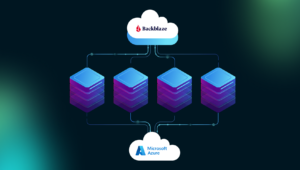"The cost of cloud data egress can be a hidden expense, sometimes making up 30-50% of a company's cloud bill."
Gartner
In this guide, we’ll define egress, explore how it works in cloud environments, break down the risks, and share best practices to control costs and security threats. If your company depends on cloud infrastructure, you can’t afford to overlook cloud egress management!
At its core, egress is the movement of data leaving a network and transferring to an external destination. This could be another network, a cloud provider, or the public internet.
How Does Data Egress Work?
Every time a business transfers files to the cloud, syncs data across platforms, or allows remote access to company resources, data egress occurs. This process is essential for modern operations, but it also introduces two major challenges:
- It Can Be Expensive – Many cloud providers charge a fee every time data is moved out of their ecosystem.
- It Can Be Risky – If outbound data isn’t properly secured, it can be intercepted or stolen.
Unlike ingress, which refers to data entering a network, egress traffic moves outward. And in cloud computing, this movement often comes with a financial cost.
Why Does Cloud Egress Matter?
1. Egress Costs Can Add Up Fast
Most organizations assume that once they pay for cloud storage, they can access their data freely. That’s not always true! Cloud providers charge egress fees based on where the data is going. Moving data within the same cloud region is typically free, but transferring it:
- To another region? That’s an egress fee.
- To an on-premise data center? More charges.
- To another cloud provider? Expensive!
According to Gartner, cloud egress costs can account for up to 50% of a company’s cloud bill. Without a clear egress strategy, businesses can unknowingly drive up costs.
2. Security Risks: Data Egress is a Prime Target for Cyberattacks
When data leaves your network, it becomes vulnerable. Cybercriminals often target cloud egress points to intercept or steal sensitive information. Some common threats include:
- Insider Threats: Employees or contractors leaking data—whether intentionally or by accident.
- Malware & Data Exfiltration: Attackers using Trojan malware to steal corporate data.
- Man-in-the-Middle Attacks: Hackers intercepting unencrypted data as it moves between networks.
Without strong egress monitoring and filtering, organizations won’t even realize when sensitive data is leaking out.
How to Manage and Secure Data Egress
Effective cloud egress management isn’t just about cost savings—it’s about protecting your data. Here’s what every organization should be doing:
1. Establish a Data Egress Policy
Create clear rules around how and where data can leave your network. Define:
✔️ Which cloud services are approved for external transfers
✔️ Who has permission to move data out of the company
✔️ How large data transfers should be monitored
2. Monitor Network Traffic for Anomalies
If a massive amount of data is suddenly being transferred out of your network, that’s a red flag! Use firewalls, SIEM tools, and data loss prevention (DLP) software to track unusual egress patterns and stop potential breaches before they escalate.
3. Implement Firewall Egress Rules
Firewalls aren’t just for blocking inbound attacks—they can limit outbound traffic too. Set up firewall rules to:
✔️ Block data transfers to unauthorized locations
✔️ Restrict high-volume outbound transfers
✔️ Log and monitor all egress activity
4. Use Data Encryption for Secure Transfers
Even if a hacker intercepts your data in transit, they shouldn’t be able to read it. Encrypt sensitive information before it leaves your network using AES-256 encryption or TLS protocols.
The NIST Cybersecurity Guidelines recommend encryption standards to ensure outbound data remains secure even if intercepted. Following these best practices helps protect against data breaches and compliance violations.
5. Reduce Unnecessary Data Transfers to Lower Cloud Egress Costs
Cloud egress costs can be minimized with a few smart strategies:
✔️ Keep cloud resources in the same region to avoid unnecessary cross-region fees.
✔️ Use caching and content delivery networks (CDNs) to store frequently accessed data closer to users.
✔️ Compress files before transfer to reduce the amount of egress traffic.
✔️ Consider private network connections (such as AWS Direct Connect or Azure ExpressRoute) for lower-cost, high-volume data transfers.
The Bottom Line: Why Data Egress Management Matters
Data egress is a hidden cost and a security risk that many organizations fail to address—until it’s too late. Whether you’re concerned about rising cloud bills or data breaches, managing cloud egress should be a top priority.
By implementing the right policies, monitoring tools, and security controls, businesses can protect their data and reduce unnecessary expenses.
Key Takeaways
✅ What is egress? It’s the movement of data leaving a network, often with security and financial risks.
✅ Cloud egress fees can be costly, especially for companies with high outbound data transfers.
✅ Firewalls, monitoring tools, and DLP software are critical for protecting egress traffic.
✅ Smart cloud architecture choices can significantly lower egress expenses.
Start taking proactive steps today to secure and optimize your cloud data egress strategy—because every byte leaving your network matters! 🚀





